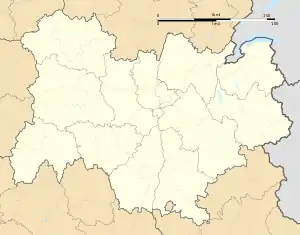Saint-Léopardin-d'Augy | |
|---|---|
 The church in Saint-Léopardin d'Augy | |
Location of Saint-Léopardin-d'Augy | |
 Saint-Léopardin-d'Augy  Saint-Léopardin-d'Augy | |
| Coordinates: 46°41′02″N 3°06′17″E / 46.6839°N 3.1047°E | |
| Country | France |
| Region | Auvergne-Rhône-Alpes |
| Department | Allier |
| Arrondissement | Moulins |
| Canton | Bourbon-l'Archambault |
| Intercommunality | CA Moulins Communauté |
| Government | |
| • Mayor (2020–2026) | Norbert Brunol[1] |
| Area 1 | 39.59 km2 (15.29 sq mi) |
| Population | 370 |
| • Density | 9.3/km2 (24/sq mi) |
| Time zone | UTC+01:00 (CET) |
| • Summer (DST) | UTC+02:00 (CEST) |
| INSEE/Postal code | 03241 /03160 |
| Elevation | 185–305 m (607–1,001 ft) (avg. 237 m or 778 ft) |
| 1 French Land Register data, which excludes lakes, ponds, glaciers > 1 km2 (0.386 sq mi or 247 acres) and river estuaries. | |
Saint-Léopardin-d'Augy (French pronunciation: [sɛ̃ leɔpaʁdɛ̃ doʒi]) is a commune in the Allier department in Auvergne-Rhône-Alpes in central France.[3]
History
The commune is a result of the fusion of two previous towns (each from a parish of the Old Regime), St. Léopardin and Augy, by order of King Louis Philippe on 18 June 1843. During the French Revolution, the commune was called Vivier.
The name of St. Léopardin comes from that of a hermit, saint Léopardin, whose life seems just as legendary as that of St. Menoux. The priory of St. Léopardin is built where the hermit had lived.
Geography
The town is bordered by two rivers: the Allier, in the northeast and north, which forms its boundary with Chantenay-Saint-Imbert and Livry, and Burge, in the east, tributary of the Allier, which forms most of its border with the town of Aubigny.
Population
| Year | Pop. | ±% |
|---|---|---|
| 1962 | 551 | — |
| 1968 | 590 | +7.1% |
| 1975 | 504 | −14.6% |
| 1982 | 436 | −13.5% |
| 1990 | 345 | −20.9% |
| 1999 | 328 | −4.9% |
| 2008 | 361 | +10.1% |
| 2013 | 342 | −5.3% |
| Source: INSEE (1968–2013) | ||
See also
References
- ↑ "Répertoire national des élus: les maires". data.gouv.fr, Plateforme ouverte des données publiques françaises (in French). 2 December 2020.
- ↑ "Populations légales 2021". The National Institute of Statistics and Economic Studies. 28 December 2023.
- ↑ INSEE commune file